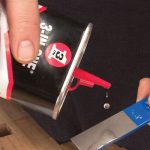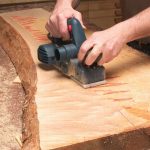We may receive a commission when you use our affiliate links. However, this does not impact our recommendations.

This month I’m finishing up work on a new book called “The Joiner and Cabinet Maker” that is a bit unusual. You can read full details about it on my personal web site, but the quick over-the-back-fence summary is this: 
A couple years ago, Joel Moskowitz at Tools for Working Wood stumbled on a virtually forgotten 1839 book that tells the fictional tale of a young apprentice and how he learns the skills to become a journeyman woodworker. We’re republishing the original text, plus Joel is adding a chapter that will be a “History Channel”-style snapshot of England in 1839. I built the three projects featured in the book using hand tools and explored many of the techniques discussed in the book.
In the course of the book, Thomas, the young hero of the story, builds three projects: a packing box, a school box and a full-fledged chest of drawers. The projects are well-built and nicely proportioned. But what is more remarkable is the small tool kit he uses to build these three projects.
I kept a running list of the tools Thomas used throughout the book, and I am almost embarrassed now by the number of tools I have in my toolbox (no, I won’t send my tools to you. I’m embarrassed , not crazy). For anyone who is interested in getting into handwork, I hope you’ll find this list comforting.
Marking & Measuring Tools
Try square
Chalk line
2′ Folding rule
Marking gauge
Panel gauge
Wooden straightedge
Marking knife
Saws
Handsaw
Sash saw
Dovetail saw
Bowsaw
Planes
Jack plane
Trying plane
Smoothing plane
Rabbet plane
Plow plane
Other Tools
Bench chisels
1/4″ Mortising chisel
Mallet
Hammer
Nailset
Bradawl
Brace and bits
Turnscrew
File
Steel plate (for clinching and straightening nails)
Shopmade Appliances
Sawbenches
Shooting board
Bench hook
If I had to add any one tool to this list, it would probably be a router plane. It’s also worth noting that the book doesn’t really get into mouldings, so most woodworkers would want to add a few moulding planes as well.
Building these three projects with a limited set of tools was a bit like going on a primitive camping trip. I was happy to return to civilization and fire up the table saw, powered jointer and planer for my next project. But I’m also dreaming of the day when I get to work like that again.
– Christopher Schwarz
Here are some supplies and tools we find essential in our everyday work around the shop. We may receive a commission from sales referred by our links; however, we have carefully selected these products for their usefulness and quality.










This reminds me of my first project for my new wife over 40 years ago-we still have it-a corner hutch.Shortly after getting married and moving into our first house, I decided to build something, so I built the hutch to be practical. The only tools I owned at the time were a circular saw, a bayonet saw( now called a jig saw by some),a hand coping saw and a few other hand tools. I still get compliments on my work.Bob Tatem
Chris,
Sounds like a great read…I’m really looking forward to it. Can’t get enough of good WW literature. I love going through older titles and antique text books but they can sometimes feel like a workout for the brain cells. It’ll be nice to have an interpretation. 🙂 This summer while on the coast I built a small project using a very minimal tool list; it was intentional trying to keep things simple. A refreshing change from my usual day to day, I agree whole heartedly that while this ‘broken down’ essential tool list is fun for a project or three, it’s nice to have access to some of those specialty items we hide away in the tool cabinet.
Keep well.
Tom
Chris,
I am really surprised that you seem to have forgotten the tool that *you* are famous for – the workbench!
Or did you make all these things without?
In any case, looking forward to the book.
Mike
Best of luck with the new book! Look forward to reading more details about the projects you have in it.
Jon @ WoodMarvels.com
That sounds like a really cool book. Let us kow when we can order one.
C&W, eh? Well, that explains it. I’ve been spending my time remouthing Auburn and Ohio jointers and smoothers, and I’m finding a couple of gotchas that aren’t mentioned in Hasluck or Jones. Or Dunbar, for that matter. But there are solutions. I just doubt I can implement them before Valley Forge.
Coming home with a receipt from C&W may not sit well with the treasurer in the Dugan household.
Tom,
The handsaw might have a rip filing. Or some other filing. We don’t know. Likewise with the backsaws. How was the sash filed? Good question.
That jack is for nasty work. I have a wooden smoothing plane that works very well (thank you Clark & Williams).
Chris
"How to make $40,000 a year woodworking"
Well, first you start with $80,000 …..
Curious that the author didn’t feel the need to include a ripsaw, and consequently no jointer. But a panel gauge?
Did you get a wooden try plane fettled to the point of wispy shavings, or fall back on Mr. Bailey’s inventions?
Peter,
Likely the book was a commercial flop, which is why it doesn’t show up much in the literature. You’ll find references to it in Google Books, but not much else. A few libraries have it.
We’re very excited to be bringing this thing to light. It’s fun to read: woodworking fiction! It will join the other woodworking fiction title ("How to Make $40,000 a Year Woodworking").
And there’s a villain: Sam! Naughty Sam who never sharpens his tools.
You should consider posting your essential tool list for the 17th century apprentice on your blog. I think that would be a cool list to compare!
Chris
Chris: I had never heard of this book til I read your posting about it last week or so. I look forward to reading it.
re: the tool list. I could lose a few, if I can add my hatchet…I might not need it, but wouldn’t want to be without it.
PF
A turnscrew is an antiquated word for screwdriver. Sorry for not mentioning that.
And there is some mention of clamps in the book, though likely not as many as a modern shop has. When you use hot hide glue, you can rely more on rub joints than on clamps.
Chris
For the budget I work under, that’s a pretty good list of tools. I don’t have some of the specialized planes, but I use a power router for dadoes and rabbets. I have a few Japanese saws which substitute for those saws. I also use a circular saw to do long rips.
What does Thomas do for clamps? And what’s a "turnscrew".
Sean,
Here were my "ground rules:"
1. The hero in the story started with lumber already thicknessed and in some cases ripped to particular widths. So I did, too. So I dressed the lumber with machines to thickness. Then it was all hand work.
2. At one moment of weakness, I ripped six boards to width on my table saw. I still feel guilt about that.
Other than that, everything was by hand. It took me five to six months of nights and weekends to build the three projects.
The book isn’t a comparison between hand and power techniques by any means. It is pure hand work. In fact I even debated whether to use metal-bodied planes at all (I ended up using both).
Chris
So you built that dresser with only the tools listed?? This isn’t like that "tabouret table two ways" thing where electrons were brought to bear on the hand tool version where convenient, right? I’ll be anxious to see the result and hear whether you found that the product was affected by the strict exclusion of electrons.
Looking forward to the book.
Mattias,
It was intended for kids considering an apprenticeship in the craft. But I think it’s a great book for anyone who wants to explore handwork. It focuses on basic skill like no other early book I have ever found.
Chris
Chris, That sounds like a great book for beginning woodworking with kids. Is that the idea, or is this book intended more for the adult woodworker as a guide or introduction to a simpler kind of woodworking?
I guess I shouldn’t speak for you. Who is this book intended for? Either way, sign me up!
Chris,
Looking forward to the ‘new’ book by you and Joel.
Stephen